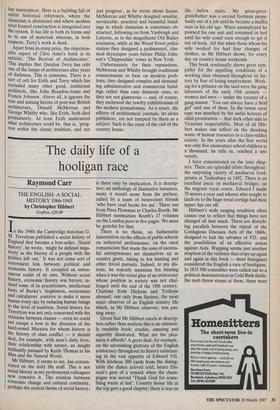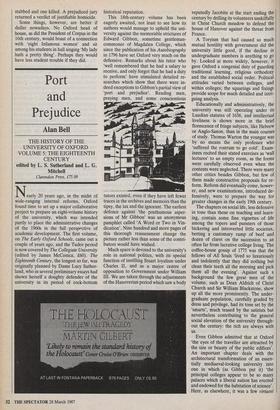The daily life of a hooligan race
Raymond Carr
THE ENGLISH: A SOCIAL HISTORY 1066-1945 by Christopher Hibbert Grafton, £20.00 In the 1940s the Cambridge historian G. M. Trevelyan published a social history of England that became a best-seller. 'Social history', he wrote, 'might be defined nega- tively as the history of a people with the politics left out.' It was not some sort of convenient link between political and economic history. It occupied an auton- omous realm of its own. Without social history, economic history was barren; in- deed some of its practitioners, intellectual heirs of Burke's `Sophisters, economists and calculators' contrive to make it more barren every day by reducing human beings to the level of numbers. Social history for Trevelyan was not only concerned with the relations between classes — even he could not escape a bow in the direction of the hard-nosed Marxists for whom history is the history of class conflict — it should deal, for example, with men's daily lives, their relationship with nature, an insight brilliantly pursued by Keith Thomas in his Man and the Natural World.
Mr Hibbert, it seems to me, has concen- trated on the daily life stuff. This is not social history as my professional colleagues now conceive it. The relation between economic change and cultural continuity, Perhaps the central theme of social history, is there only by implication. It is descrip- tive; an anthology of illustrative instances, many it would seem from his preface, culled by a team of benevolent friends 'who have read books for me'. These run from Piers Plowman to Charles Booth. Mr Hibbert summarises Booth's 17 volumes on the London poor in five pages. We must be grateful for that.
There is no thesis, no fashionable lamentation on the effects of public schools on industrial performance, on the rural romanticism that made the sons of success- ful entrepreneurs set themselves up as country gents, taking to fox hunting and other trivial pursuits. Indeed, to my dis- tress, he scarcely mentions fox hunting when it was the social glue of an aristocracy whose position in society was not chal- lenged until the end of the 14th century. Citations from Dickens and Trollope abound; one only from Surtees, the most exact observer of an English country life which, as Mr Hibbert observes, was pas- sing away.
Given that Mr Hibbert excels at descrip- tion rather than analysis this is an eminent- ly readable book; erudite, amusing and superbly illustrated. What are the plea- sures it affords? A great deal, for example, on the astonishing gluttony of the English aristocracy throughout its history culminat- ing in the vast appetite of Edward VII. With kitchens 300 yards from the dining- table the dishes arrived cold; hence Dis- raeli's gem of a remark when the cham- pagne was served 'Thank God for some- thing warm at last'. Country house life at the top gets a good chapter; there is less on life below stairs. My great-great- grandfather was a second footman perpe- tually out of a job until he became a muffin man in his old age. When unemployed he pawned his one suit and remained in bed until his wife could earn enough to get it out of hock. All this when those whom his wife worked for had four changes of clothes, as Mr Hibbert shows, for every day on country house weekends.
This book continually shows great sym- pathy for the appalling conditions of a working class obsessed throughout its his- tory by fear of losing employment. Work- ing for a pittance on the land were the gang labourers of the early 19th century — women and men — under the tyranny of a gang-master. 'You can always have a field girl' said one of them. In the towns rural rape was matched by the awful horrors of child prostitution — that dark other side to Victorian respectability. Most of all Hib- bert makes one reflect on the shocking waste of human resources in a class-ridden society. In the years after the first world war only five elementary school children in a thousand, he tells us, reached a uni- versity.
I have concentrated on the later chap- ters. There are splendid titbits throughout: the surprising variety of mediaeval food; pirates at Teskesbury in 1492. There is an excellent piece on mediaeval bridges; on the migrant royal courts. Edward I made 70 moves a year and whores who sought to latch on to the huge royal cort6ge had their upper lips cut off.
Hibbert's wide ranging erudition often causes one to reflect that things have not changed all that much. There are disturb- ing parallels between the repeal of the Contagious Diseases Acts of the 1860s, designed to halt the advance of VD, and the possibilities of an effective action against Aids. Wapping seems just another eruption of the violence that crops up again and again in this book — most foreigners considered the English a race of hooligans. In 1833 500 constables were called out to a political demonstration in Cold Bath fields: the mob threw stones at them, three were stabbed and one killed. A prejudiced jury returned a verdict of justifiable homicide.
Some things, however, are better if duller nowadays. No Oxford head of house, as did the President of Corpus in the 16th century, would boast of a connection with 'eight Infamous women' and sit among his students in hall singing 'My lady hath a pretty thing'. Perhaps they would have less student trouble if they did.



















































 Previous page
Previous page